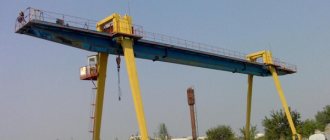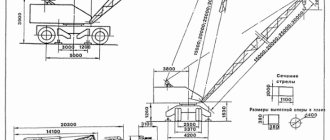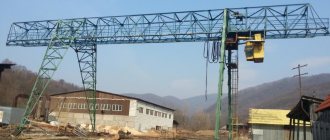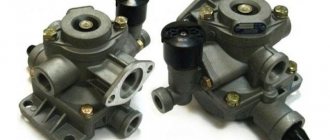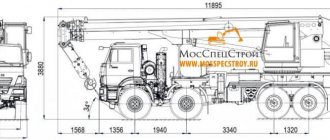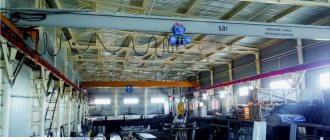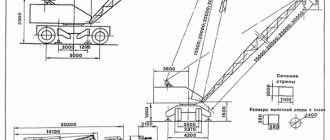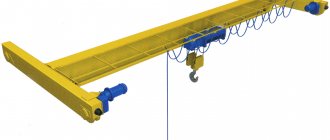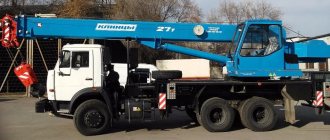The wall-mounted cantilever crane is used to move loads in areas with limited space, in repair shops, assembly lines, in production and construction sites near walls. We produce cantilever rotary wall cranes of various modifications in standard, fireproof and explosion-proof versions. Technical parameters of basic cranes are listed below on this page. It is possible to manufacture to order in accordance with the needs of your business. In the standard version, the tap is coated with paint that is resistant to operation in temperatures from -20°C to +40°C. If there is a technical need, the tap is coated with a special paint that is resistant to chemical attack and temperatures from -60°C to +60°C.
To ensure that our engineers can select the crane with optimal characteristics for you, please fill out the short survey form below. We will analyze the information received from you with the required technical data and provide guidance on the cost and delivery time of the equipment.
Get a consultation
and find out the cost of a crane with specific technical parameters.
Fill out your contact information in the form below and attach a questionnaire, terms of reference or project.
Or choose your options using the online survey
Selection of a cantilever wall crane according to the specified parameters
Time is Up!
Specifications
This installation is equipped with a rotating console, a column on which there are 2 supports. The design also provides a protective coating that protects the equipment from premature wear.
This crane is designed to mechanize the process of lifting and moving various loads. It is installed both in open areas and indoors. The console is rotated manually.
The design also includes radio control, a brake emergency mechanism that stops the operation of the electric motor in the event of an emergency, and limit switches.
Technical parameters and characteristics of the crane:
| Maximum lifting weight | 5000 kg |
| Maximum lifting height | 36000 mm |
| Reach of the working unit | 12000 mm |
| Rotation angle of the structure | 180° |
| Operating temperature | -40°…+40°С |
| dimensions | Length - 1350 mm Width - 900 mm Height - 1620 mm |
| Limiter to prevent overload | Eat |
| Number of bars | 1 |
| Full mass | 193 kg |
| Load lifting speed | 4 m per minute |
| Load moving speed | 20 m per minute |
| Required electrical system voltage | 380 V |
| Frequency | 50 Hz |
| Load lowering speed | 5 m per minute |
| Column rotation speed | 2.5 revolutions per minute |
| Maximum load winch force | 17 Nm |
| Operating radius of installation | 730 mm |
To independently manufacture such equipment, calculations are carried out on the Ukosina crane. They take into account the parameters of the room in which the installation will be used and the type of work performed.
Variation of cargo altitude characteristics
The lifting capacity of column-mounted jib cranes varies from 0.5 to 16 tons. Range of other characteristics:
- boom radius, m – from 2.5 to 6 or 10;
- lifting height, m – from 2 to 4 or 5.
If the angle of rotation of the equipment is 240 degrees, the first numbers are relevant - the maximum boom reach is 6 m and the lifting height is 4 m.
Lifting characteristics of jib crane
Construction of console cranes
There are more varieties of cantilever lifting devices than those based on automobiles. They have different types of drive. On this basis, they are divided into manual and mechanical. The executive body of both units is a trolley or hoist moving along the console. The telpher is installed both on a cantilever-beam mechanism and on a column-based device.
The hoist consists of a planetary gearbox, a brake system and an electric motor. The entire structure standing on the column rotates around its axis. The manual rotary console crane makes turns manually.
The braking system stops the hoist and prevents the load from rising above the specified limit. This protects the lift from cable breaks, excess vertical load and incorrect winding on the drum. When you try to lift a load that is too heavy, the power supply system of the hoist is cut off.
A mechanical design has a motor or other device that facilitates the movement of loads. The drive is most often electric or hydraulic. Any worker is allowed to operate the crane. He controls it from the remote control without any physical effort. Depending on the design features, the lift can be stationary or mobile. Let's look at each of them.
Stationary
Stationary cranes have a greater lifting capacity, weigh more than mobile mechanisms and have larger dimensions. They are also available in a wall-mounted version. In this case, the cantilever beam is suspended from a truss fixed to the wall and transfers part of its load to the building. The beam and the cart with the load move using different types of motors. Electric drives are more often used.
The stationary electric console crane is equipped with 1 or 2 arms. On the support of the two-arm device, 2 cantilever beams are installed, allowing you to carry 2 different loads at the same time. Stationary lifting mechanisms are also mounted on columns firmly fixed to the foundation. They are installed in different places in the room: close to the wall, in the spaces between the machines. Cantilever rotary cranes, located closer to the middle of the floor, have a large rotation angle, reaching up to 360°.
Mobile
Mobile console cranes have smaller shapes compared to stationary ones. They are convenient to use in rooms with a large area. The device console is mounted on a vertical frame. The frame rests on driven wheels. A mechanism with this design is mounted on the wall and moves along it along special guides using an electric motor.
Mobile lifts are more mobile. They also move on rails laid on the floor. This method of movement increases the coverage width of the service area and reduces the number of devices in the room.
Jib crane (1t/4m)
This crane is used for lifting and moving loads weighing up to 1 ton in a horizontal plane. The maximum lifting height is 4 meters. The lift is suitable for garages, auto repair shops, and tire service centers. It is indispensable for repair, tire fitting, and emergency restoration work.
Design, general description
- The crane consists of a support post, jib, control lever, beam, boom equipment, winch with hoist, pulley, pins, clamp, vacuum gauge, transformer, cables, eyes, wheel mechanism, hook, fasteners, electric motor.
- The supporting frame is made of cold-rolled high-strength steel. It has the shape of a triangle. Two blocks are attached to it.
- There is a third block at the bottom of the mast. A steel cable passes through it, at one end of which there is a bowl-shaped hook, at the other end there is a winch drum mechanism.
- The metal corner profile rotates around the clamps fixed to the match.
- The load is grabbed using a hook.
- The multiple block system in the design reduces the amount of effort during operation.
- Mechanisms for grabbing cargo are replaceable. They are selected depending on the shape of the load being lifted.
- The boom reach can be increased. To do this, the eyes are attached to the fingers, which are supported by an additional stand.
- The mast is fixed to the working surface with special fastening units. Thanks to this, the level of its stability increases by 2-3 times.
Types of cranes
The crane-manipulator is a device with a wide range of applications. There are several dozen varieties of CMU; Some of them are shown in the illustration.
However, the classification of CMU is quite simple:
By arrow type:
- The Z-boom folds in three and when not in use is positioned across the carrier.
- During transportation, the L-boom is placed along the longitudinal axis of the chassis above the cabin or platform.
According to the base chassis:
- Automotive.
- Tractor, tracked or wheeled.
- Railway.
- Floating.
- Special.
According to the availability of a cargo platform: yes, no, replaceable (for example, a car transporter/container carrier).
By cargo moment:
- Up to 1 tm – micromanipulators.
- 1 – 10 tm – average CMU.
- Over 10 tm – heavy CMU.
Note 1. The load capacity of the CMU is not a constant value. It depends on the reach of the arrow and its inclination. Therefore, loader cranes are classified according to the product of the mass of the load and the reach of the boom - the load moment. If the load moment is 10 tm, then with an outreach of 10 m the load capacity will be 1 t, with an outreach of 2 m - 5 t. The load moment is expressed in kilonewtons per meter (kNm) or in tons per meter (tm). Each loader crane is equipped with a load-height diagram (characteristic), from which you can determine the permissible load weight at any position of the boom.
Note 2. The Russian classification of CMU by load moment is given. There is no single international classification for this parameter. Each manufacturer gives its own classification, which may differ significantly from others.
Main characteristics
Main technical parameters of lifting equipment:
Jib crane - dimensions
- classification according to GOST 25546 - 2K, according to ISO 4301/1 - A2;
- execution – U, HL, UHL;
- placement according to standard 15150 – 1, 2, 3, 4;
- device rotation drive and control – manual;
- hoist control – manual, electric remote control;
- control position – from the floor;
- electrical wire – cable connection;
- load mass during testing – 1.25 for static testing, 1.1 for dynamic testing.
The last paragraph indicates a portion of the rated load capacity indicated in the passport.
Related video: Jib crane
Jib crane
GOST 25546-82
This interstate standard regulates the requirements for crane tracks of overhead cranes, and they are quite stringent. Why? Because guides are actively used under conditions of intense and constant loads, and are also required to maintain the same geometry for a long time, even if they are laid in stressed areas, which are understood as construction sites with high intensity of work.
Also worthy of attention are large transport junctions (hubs) and warehouse complexes with large volumes of loading and unloading, metallurgical, chemical and other significant plants and factories. A separate line goes to large-scale industrial enterprises that are just being put into operation, as well as facilities where large-sized and super-heavy objects are moved.
It is understood that the design of guides, both standard and individual, should be carried out by employees of specialized bureaus and other specialized organizations who have not only the necessary experience, but also all current permits. This is necessary so that later there are no problems with installation, so that the developed drawings are approved by all control authorities without any problems. In addition, a professional solution to the issue is the key to the rationality of the proposed measures, taking into account deviations and other technical features that apply in a particular case.
Specifications
The Ivanovets truck crane has universal capabilities that allow it to work effectively in all weather conditions and in difficult areas. The main purpose of the unit is to unload and load construction materials, as well as repair and installation work. The crane has a hydraulic drive type, ensuring uniform load distribution and smooth operation of the main mechanisms.
Separately, it is worth noting the compact size of the truck crane, which allows you to move freely through busy areas and in poor road conditions. For example, the machine maneuvers perfectly among multi-story high-rise buildings, reducing the risk of any damage to a minimum. The Ivanovets truck crane has high temperature limits and can operate both at -40 degrees and + 40.
In an effort to protect builders as much as possible from possible accidents, engineers have developed a special load limiter, which is found in the latest versions of the KS 3577 series. The device works efficiently thanks to a built-in microprocessor containing metric data regarding the loading of a truck crane. Using the limiter, the operator can independently calculate the load level of the main boom and the extension distance, and also, if necessary, limit turns and the lifting rate.
Important Technical characteristics of popular models of Japanese Komatsu excavators on crawler and wheel drives
Considering the standard version of the KS-3577, the following technical characteristics can be highlighted: the diesel engine power is two hundred and forty liters per second, and the rotation speed is one revolution per minute. The total volume of the equipped crane in transport condition can reach sixteen tons, and the load capacity coefficient is fourteen tons. The Ivanovets truck crane has dimensions of 9.8x2.5x3.6 and a 4x2 wheel shape.
The main model of truck cranes of the KS series is the KS 3577 based on the MAZ 5334
As you understand, the unit has quite attractive technical characteristics and meets many modern standards. Today the crane can be found at large construction sites in Moscow, St. Petersburg, Kyiv and Minsk. The Ivanovets truck crane is also well supplied to Eastern European countries, in particular Poland, Lithuania and Latvia.
How to choose a faucet
Selecting an assembly crane based on technical parameters involves taking into account:
- load capacity;
- arrow departure.
The unit is also selected depending on the type of intended installation operations.
By load capacity
Selecting a crane based on technical parameters of lifting capacity involves taking into account the total mass of the transported cargo.
If the weight of the load being lifted is no more than 5000 kg, then overhead cranes are suitable. Such equipment is designed to work in conditions of intensive operation of crane installations. The equipment is equipped with an additional braking system, limiting devices and frequency conversions. Among the advantages are:
- high level of security;
- ease of installation;
- accessible repair base;
- low power consumption.
Such installations are based on the chassis of all-wheel drive trucks, which makes it possible to increase their technical performance. Such models of crane installations are distinguished by a high level of reliability, a wide range of tasks performed and a comfortable driver’s cabin. The crane is controlled remotely.
In off-road conditions, snowy conditions and for lifting heavy loads, equipment is used that is capable of transporting cargo weighing up to 5000 kg. It is equipped with a powerful diesel engine and counterweights weighing 3000 kg.
According to the arrow's reach
and other crane installations are also selected according to such characteristics as: hook lifting height and boom equipment reach.
If the length of the boom itself is 9700 mm, and the reach is 3400 mm, then such construction equipment is capable of transporting a load weighing no more than 25,000 kg. This unit is suitable for installation work and maintenance of buildings. The equipment is equipped with a diesel engine whose power does not exceed 240 hp. With. There is an additional braking system and a center wheel lock with hydraulic power steering.
If the maximum boom length is 21,700 mm and its reach is 6,000 mm, then such equipment can be used when transporting heavy loads to a height of up to 28,000 mm. The crane is equipped with a 300 hp diesel power unit. and hydraulic power steering. The crane installation is controlled remotely using special handles located in the driver’s cab. It is recommended to choose such a crane during the construction of multi-storey buildings.
For the construction of industrial facilities, cranes with boom lengths of up to 100,000 mm are used. They are capable of lifting heavy loads and installing specialized equipment, for example, at nuclear power plants, oil refineries, etc.
By type of work
Many people are interested in the question of how to choose a crane for construction, loading and unloading operations, for the construction of various structures, etc.
Depending on the type of work, the following types of cranes are distinguished:
- On a car chassis. Such equipment is recommended to be used to perform a small amount of work. The crane has a high level of mobility and maneuverability.
- On a tracked chassis. The equipment is used on large construction sites. This crane cannot be driven on city roads, so it must be transported to the work site.
- On a pneumatic chassis. This technique is capable of reaching speeds of up to 20 km/h and is used when performing construction and installation work at sites remote from the city.
Bridge - suitable for performing loading and unloading operations and technological operations in workshops at an industrial enterprise.
Boom - necessary for construction and installation work during the construction of various structures.
The tower crane is designed for the construction of buildings up to 16 floors high.
Gantry cranes are used to move goods in warehouses and when servicing hydraulic facilities.
Device
The design of this lifting machine includes the following parts and mechanisms:
- support post;
- jib;
- beam;
- control lever;
- winch with hoist;
- lugs;
- boom equipment;
- fingers;
- pulley;
- clamp;
- transformer and vacuum gauge;
- wheel mechanism;
- cables;
- fasteners;
- cup-shaped hook;
- Electrical engine.
A complete design drawing of this equipment is provided in the user manual.
The supporting frame of the device is made of high-strength steel and has a triangular shape. The corner profile is made of iron and rotates around two clamps, which are located on a special mast. There are 2 blocks attached to the support type frame, and a third block is located at the bottom of the mast. A flexible cable made of steel passes through it, ending at one end with a bowl-shaped hook. This type of hook is used to grab cargo. At the other end of the cable there is a self-winding drum winch mechanism.
To reduce the amount of effort, the design of the installation includes a system of multiple blocks.
Mechanisms designed to grip the load vary depending on the shape of the object being lifted: for example, to transport bricks you will need a platform with overall dimensions of at least 3000 * 900 mm. To move a round-shaped load, a simple platform made of logs with a diameter of 270-320 mm is used.
To increase the reach of the installation's working part, it is recommended to strengthen the crane's eyes on the fingers attached to it. They should be supported with a special additional stand.
To increase the level of stability of the mast, it is secured to the working surface with fasteners in one or two places. If the height of the mast exceeds 20,000 mm, it is recommended to additionally install a fastening in the middle of the structure.
The lifting angle of the load, the length of the boom and the angle of inclination of the installation itself can be controlled using special mechanisms that are connected to the installation.
Pioneer type lift
This unit is lightweight and highly mobile. It assembles and disassembles simply and quickly. It can even be brought to the site in a Gazelle, the work done, and then disassembled and taken away. Moreover, it is quite possible to install the crane on the ground, in a pit, on the roof, as well as on building floors.
Pioneer lifts are made by many enterprises specializing in the production of all kinds of lifting equipment. We can mention the domestic one, Impulse LLC from Kirov, PKF Chelny Crane Company LLC.
There are three main modifications of the crane, the lifting capacity of which can be, respectively, 0.5, 0.75 and 1 ton (this is the maximum). The boom can be solid or collapsible, and the supporting frame, which serves as the base of the unit, can be equipped with wheels or have a stationary design.
Application
This jib crane is capable of moving any objects, working intensively in heat of forty degrees and in frosts down to minus forty. It will easily deliver building materials, installation structures, currently needed equipment, tools and inventory to the roof, as well as to any of the floors.
During roofing work, a unit equipped with a convenient rotating boom will help to quickly supply the required volume of mastic, rolled roofing or insulating material to the roof.
At manufacturing enterprises, the Pioneer crane is often used for carrying out repair work, as well as for quickly loading and unloading any materials, machines, and metal structures.
Photo of Pioneer type lift
The Pioneer type lift is used by trade enterprises, as well as wholesale warehouses. The lift will help to quickly ship heavy rolls of linoleum, pallets with ceramic tiles, and various lumber to the buyer.
Advantages and disadvantages
Advantages:
- Simple and extremely reliable design, ease of use.
- The speed of assembly and disassembly is no more than half an hour.
- High mobility, which allows the crane to be used even at distant sites.
- There is no need to register the lift with Rostekhnadzor.
- There is no need to make a pit before work, and no anchors are required during installation.
The boom's 360-degree rotation makes lifting and lowering loads easy.
Low cost, low energy consumption.
Flaws:
- Flexibly suspended cargo does not always create comfortable and safe conditions.
- The maximum weight that the crane can lift is from 500 to 1000 kilograms (depending on the modification).
Device
The design of this collapsible mechanism is extremely simple. The crane consists of the following elements:
- The main supporting frame (dismountable, bolted, can stand on wheels), on which the second frame is mounted - a rotating one.
- Safety guy ropes, cargo rope, counterweight, electric drive.
- A rotating boom (which can be solid or collapsible, bolted), equipped with a jib.
- The final stop mechanism (which is located at the end of the boom), the limit switch (it is installed on the lifting mechanism).
Scheme of Piner type lifts
Crane control
Managing a CMU requires special skills and experience. Just take a closer look at the most ordinary garbage truck - how many handles there are to control the boom. Modern cranes, especially heavy and special ones, are often equipped with a system of various sensors and an on-board computer that works on the principle: “show-what-from-where.”
Important Russian military all-terrain vehicles: tracked and wheeled amphibians for small army units
There are known experimental models in which information is projected onto the cockpit glass, as in combat aircraft, and with an eye-tracking system borrowed from the same. They control such machines not only with their hands and feet, but also with their eyes.
Pioneer crane, lifting capacity 500, 750 and 1000 kg – sale, spare parts
The Anix trading house offers for sale reliable, safe, maneuverable Pioneer cranes of various lifting capacities. If you are interested in high quality combined with affordable prices, contact us!
Crane Pioneer lifting capacity 500 and 750 kg
The Pioneer crane allows you to lift a load to a height of up to 6 m (for the Pioneer model 1000 kg, for the Pioneer 500 kg and 750 kg models the height is 4.5 m), if you install the equipment on the roof of a building, the height can reach 50 meters. Depending on the model, Pioneer cranes can have different lifting capacities. The most popular models today are Pioneer 500 kg and Pioneer 1000 kg. You can find models with a load capacity of 750 kg.
Pioneer cranes 500 kg, 750 kg, 1000 kg have a large number of operational advantages. Convenient transportation of special equipment is ensured by the possibility of disassembly.
Also among the advantages of the models is the reliability and ease of operation of the system, low cost and minimal maintenance costs.
In addition, no special training is required to operate the equipment.
Monday Friday
8:00–18:00
Saturday
10:00–16:00
Diagram of the Pioneer crane with a lifting capacity of 500 kg
In our company, the Pioneer crane is presented in various modifications. For example, the Pioneer 500 kg crane is made in two configurations: the boom can be regular or collapsible. The Pioneer crane 1000 kg may have wheels, or it may be an adjustable model.
In any case, the design of the model includes a support frame, a turntable with a winch, a boom and a special coupler for it, automation, an engine, a cable, a counterweight, and a hook for coupling the load. Depending on the height to which the load needs to be lifted, special equipment can be installed either on the roof/floor or on the ground.
In the first case, the lifting height can reach 50 m. If the crane is standing on the ground, then the Pioneer 1000 kg model is capable of lifting a load to a height of up to 6 m, the Pioneer 500 kg and 750 kg models - up to 4.5 m. Welded metal is used in the production of the base frame on which the king pin is mounted, moving with the help of rolling bearings.
The simplicity and reliability of the Pioneer crane allows you to work with it without prior preparation. In addition, the operation of Pioneer cranes 500 kg, 750 kg, 1000 kg does not require any major investments - no expensive repairs, no consumables, spare parts, and so on.
The simplicity and efficiency of all operations is ensured by the operation of an electric drive, consisting of a motor, gearbox and winch. The Pioneer 500 kg and 750 kg cranes require manual boom rotation (a swing lever is used), but the Pioneer 1000 kg model is equipped with an electric boom rotation function, as well as a function for changing the boom angle - this increases the boom reach, but the load capacity decreases.
Quality:
The manufacturer guarantees that the equipment meets the technical requirements set out in the technical specifications or national standard. You can familiarize yourself with the national standards for the products offered in the engineering standards section.
Enter cargo parameters: Dimensional parameters of the cargo affect the calculation of the cost of its collection/delivery. When calculating, in addition to the volume and mass of the load, indicate its length/width/height.
| Length, m | Width, m | Height, m | volume, m3 | Weight, kg |
Add a place
From: Swap cities
City: SЂР°СЃС‚ентовка The canopy makes loading the cargo easier. Therefore, either the side canopy or the top can be carried out. The full canopy of the semi-trailer allows loading from above and from the side.”>
манпулятор
Where to Swap cities
City: RіРёРїРµСЂРјР°СЂРєРµС‚ растентовка The tilt lining makes loading the cargo easier. Therefore, either the side canopy or the top can be carried out. The full canopy of the semi-trailer allows loading from above and from the side.”>
манпулятор
Additional services
пломба паллеты страхование ночь Declared value of the cargo Please check and indicate the declared value of the cargo
* The above deadlines are approximate, the actual period may differ either up or down
Please note: • the presence of additional packaging can significantly affect the cost of cargo transportation both by road and by air; • if the cargo is included in the list of shipments subject to mandatory rigid packaging, in accordance with the terms of the contract it will be packed regardless of whether this service is ordered by the forwarder. You can view the list of goods subject to mandatory rigid packaging here; • the results of calculations performed using the PEC calculator are preliminary
The final cost is determined only after delivery of the cargo; • we strongly recommend that our clients take care of the timely receipt of the cargo at the destination, since in case of forced storage of the shipment for more than four days, an additional fee will be charged.
Design and principle of operation
The crane beam consists of the following parts:
- a bridge made of an I-beam;
- telpher or hoist - devices moving along the bridge to transport goods;
- end beams with running wheels;
- struts for attaching the monorail.
The end consoles are attached to the bridge using a rigid fastening method. There are 2 types of devices for moving loads in bridge design:
- supporting, used over large areas;
- hanging, used in small spaces.
Installation of suspended bridge-type lifting equipment does not require the installation of crane trestles.
A telpher is a mechanism that lifts and moves large weights and is powered by an electric drive. It is more powerful than hoists and can move loads weighing up to 10 tons.
The devices are used at temperatures of +40…-40 °C. When moving dusty materials, periodic inspections of mechanisms and removal of dust from equipment components are required. When using them outdoors, electrical parts are covered with special covers to prevent precipitation.
What is the difference between a crane beam and a hoist?
A hoist with electric gear motors and a crane beam differ in that the first is part of a lifting mechanism for transporting goods. It can be used as a standalone device. Its suspended design is compact and does not clutter up the space of the room.
The telpher easily moves along the monorail. There is a difference in the installation and price of these 2 types of forklifts. There is some difference in the movement of these mechanisms. The hoist moves up and down and right and left, and the bridge mechanism moves up and down, right and left and back and forth.
Types of lifting consoles
Devices of this type are classified according to their mobility. The jib crane can be:
Types of jib cranes
- stationary – fixed at the workplace and does not move;
- mobile – such a device can move within predetermined limits.
The design of electric jib-slewing cranes can be equipped with manual rotation of the console. This solution allows you to use the equipment in places where there are no sources of electricity.
The wall-mounted design of the device is characterized by high reliability and performance characteristics. The mechanism is installed on the wall to move goods nearby.
Mechanical devices are controlled using a remote control. Both manual and mechanical variations are equipped with electric hoists or manual hoists. The latter option is used for relatively light materials. Hoists are designed to work with heavy objects.
Wall mounted jib crane
My own master
Many owners of dachas or private houses make their own cranes. This is very convenient, since each mechanism (be it a simple motor or a full-fledged hydraulic drive) will be configured and adjusted to the person who made it. In addition, such a mechanism helps not only to carry heavy monolithic blocks, but also to deliver light loads, such as, to the top of the building.
Alas, it’s unlikely that you’ll be able to apply hydraulics to your creation. But it will be possible to replace it with an equally worthy homemade lifting machine that is not too difficult to use.
Many will probably have a completely adequate question: “Where can I get the parts?” The answer will be very short and unequivocal - at a landfill. If you push your innate disgust into the background and take a walk through many of the interesting landfills of your native land, you can find a lot of useful things at a construction site.
So, in order to create a Pioneer faucet with your own hands, the first thing you need to do is find an I-beam and a rectangular pipe. Immediately, the condition is stipulated that the I-beam must fit freely into the pipe. It is placed on sliding guides, and thus a telescopic unit is obtained.
Important Hyundai Porter refrigerators for transporting products
In order for the crane to finally be able to function, it must be equipped with certain cables of the smallest diameter. You will have to spend money on them in a specialized hardware store (although you may also be lucky to find them in a landfill). You can use the channel as a material for welding the support and rotary frames. It is the channel that allows for good fixation of the crane on the surface. Usually, the roof of the object that is being built is this surface.
In order for work with the machine to proceed without incident, and also to protect yourself, it is necessary to weld a rectangular-shaped ballast pad.
One foundation block will be enough to lift a load weighing half a ton. To start the lifting process, you can purchase an electric motor in a special store, and then connect it to a winch from a UAZ.
Connecting electrical mechanisms
To start the lifting mechanism electrically, you will have to use the services of an electrician. The connection procedure itself is not too complicated, but still, for your own safety, you should trust a person who has experience working with electricity.
After this, the DIY Pioneer crane is ready for use.
Homemade crane for building a house
Almost any construction site cannot be done without special equipment, especially a construction crane. It becomes an indispensable assistant when it is necessary to lift heavy loads to different heights.
Most people associate this technology with huge size, but there are many types of faucets that are ergonomic and compact.
You can even do some options yourself, saving personal savings during construction. In this article we will look at how to assemble a homemade Pioneer crane for building a house.
Peculiarities
The key features of this device are the installation, gripping mechanism and usage features. The installation feature is a cantilever beam, which can be stationary, rotary or mobile. The gripping mechanism is suspended directly from the console or a trolley moving horizontally along it. The electric hoist is responsible for the function of raising and lowering. For mobile options, travel paths are provided.
Characteristics:
- load capacity up to 2t;
- lifting loads - up to 4 m in height;
- boom reach - up to 5 m;
- operating temperature - from - 20 to + 40C;
- electricity consumption - 380 V/50 Hz.
DIY crane
Hello dear homemade people.
Do you really need a crane? So let's do it. Small-sized, with a boom that rotates and lifts, with a carrying capacity of two bags of cement, or 30 pieces of brick, or 3 large buckets of concrete.
I made one for myself, and now I can’t imagine how my wife and I could have built a two-story cottage with an area of 200 m2 if this crane had not existed.
Here are the drawings, and below is a detailed description of the process.
Just a tiny digression first: if anyone is looking for a simple lift for beams or logs, then take a look here.
Materials for the crane were mainly found in scrap metal. We only had to buy bearings, a winch, and order parts for the turning mechanism from a turner.
And I also had to pay a welder, since I myself cannot do welding work, due to some vision problems.
In general, this crane cost 5,000 rubles, which cannot be compared with the amount of work that I managed to complete with its help, because the “cheapest” helper in our region costs 800 rubles per day.
I’ll immediately make a reservation that during operation, my faucet revealed some shortcomings, which I will point out and advise on how to correct them. So your faucet will be a little different from mine.
Let's start with the rotating mechanism
It consists of six parts that need to be ordered by a turner, and two bearings.
As you can see, there are no dimensions in the drawing. The fact is that you don’t have to follow the exact size, like mine. After all, we make the faucet from available material, and I cannot know what size channel or I-beam, or what kind of pipe you will have at hand.
A little more or a little less doesn’t matter in my design. And you will understand this from further instructions. And having generally estimated what materials and parts you have, determine what dimensions to take for the manufacture of the rotating mechanism.
The mechanism has two bearings. At the top, between the housing and the base, there is a support bearing. Below, again between the housing and the base, there is a simple radial bearing.
Here you need to calculate the internal diameter of the body and the outer diameter of the base. Both of these parts must fit very tightly into the bearing.
Or rather, the housing should be mounted on the bearing, and the base should fit into it. Thus, both of these parts are connected. For more reliable fixation of the radial bearing, a nut is screwed onto the housing from below. The thickness of the threaded and retaining parts of the nut is at your discretion, but not less than 3 mm.
Then this unit is attached to the platform with a bolt (I have an M 26), which attracts the base to the platform. Thus, it turns out that the platform and base are a stationary part of the mechanism, and the body with the nut is rotating.
Now a little about what practice has shown. Towards the end of the season, the radial bearing weakened a little, and a barely noticeable play formed in the turning mechanism.
But with a boom length of 5 meters, this play became noticeably noticeable, so I recommend installing a hub bearing, 36 mm wide, instead of a radial bearing.
Here in Kazan, support and wheel bearings can be bought for 500 rubles both. And to tighten the bolt securing the base to the platform, you will need a spanner with an extension, and definitely two washers - a flat one and a lock washer.
Our next node will be the rack.
To make it you will need a piece of pipe (I have d140) and four pieces of channel. You need to estimate the height of the stand so that when finished it will be just right for you. Even two centimeters lower. Then it will be convenient to turn the winch when operating the crane.
Since God is unlikely to send you a piece of pipe with an evenly cut end, you will have to cut one end yourself. To do this, we take a car clamp, or make a clamp from a strip of tin, and tighten it on the pipe.
When tightened, the clamp will try to position itself on the pipe as evenly as possible, and if you help it a little (by eye), you will get a fairly even line around the circumference of the pipe, which you just have to draw, then remove the clamp, and cut the pipe along this line using a grinder .
Then, the rotating mechanism platform is welded to this flat end of the pipe. Now it’s clear why I didn’t give the dimensions in the drawing? You still have to order the rotating mechanism. And you can find a tuba. This means the diameter of the platform can be ordered according to the diameter of the pipe.
Now the legs. They need to be welded so that the stand does not collapse. How to do it? Firstly, they need to be cut to the same length.
Then hang the pipe with the welded platform, passing the rope through the hole in the center of the platform, and place your legs diagonally towards the pipe, so that in the end, the pipe remains hanging evenly, and your legs rest against it on all four sides.
As soon as the balance is found, you need to draw by eye the corners of the channels that abut the pipe, and trim them with a grinder as shown in the photo.
After trimming the corners, lean your legs against the pipe again, catch your balance, check with a rack and tape so that they form an even cross, and secure them with welding. After tacking, check the cross again, and you can weld.
Read also: Do-it-yourself zigzag UHF antennas
All that remains is to make the support cross itself. It can be made from any rigid profile. At first there was an idea to put it on wheels made of bearings, but time was running out, and it didn’t come to the wheels, but actually it would have been nice. The unit turned out to be quite heavy, and it was difficult to move it.
The length of the arms of the cross is 1.7 meters, although as operation has shown, this cross does not play a particularly large role in the stability of the crane. The main stability is provided by balance, which we will talk about later.
The cross is not welded to the legs, but is attached with M 10 bolts and nuts. This was done for ease of possible transportation. The legs were reinforced in anticipation of installing wheels, but they never got around to it, although the idea of installing them is still there.
The stand with the rotating mechanism is ready, now let's move on to the crane platform, on which the counterweight, winches, and boom will be installed. I found a one and a half meter I-beam, 180 mm wide, for the platform. But I think you can use a channel and even a 150 x 200 beam under it.
At first I even wanted to use timber, but since I found an I-beam, I chose it. The platform is attached to the rotary mechanism body with four bolts and M 10 nuts.
If you use timber instead of an I-beam, then you will need to make additional platforms for it, above and below. You can “encircle” it with two pieces of channel and tighten everything with bolts.
But we’ll wait with the bolts for now, since the place where the platform is attached to the rotating mechanism will need to be selected based on balance. That is, the crane boom must be balanced by a block for counterweights and a winch. That is, the crane must stand confidently on the stand and not fall over.
Next will be the counterweight block.
I have it made from pieces of the same channel as the platform, but it can be made from anything, and in any way. The main thing is to have a container in which you can install loads, so that if necessary, you can increase the counterweight.
Now about the winch. My winch is installed with a capacity of 500 kg, with a brake. And once again, as practice has shown, such power was not enough to lift a load of about 100 kg.
That is, you can lift it, but you have to lean so hard on the handle that when lifting to a height of more than 5 meters, you get tired very quickly. For such a crane you need a winch of 1 - 1.5 tons.
There was also supposed to be a second winch for lifting the boom, but at that time, having visited a bunch of shops and markets, I could find only one winch with a brake, which you see in the photo. Therefore, instead of a second winch, a temporary tension cable was made, the length of which is still changed using clamps.
Unfortunately, there is nothing more permanent than a temporary structure. I still recommend that you install a winch instead, preferably a worm one. Its speed is low, and the brake, whether up or down, is dead. That's what an arrow needs.
All that remains is to make an arrow, which is what we will do. The boom consists of a mount with a shaft, a beam 150 x 50, and a tip with a pulley.
First, the mounting body. It is better to make it from a piece of channel wood.
Any round timber with a diameter of 20 to 30 mm will do for the shaft. For example, I cut off a piece of the rotor shaft of some old engine. Then we bend it in a vice, put two brackets around this shaft and fasten it to the channel, into which the beam will then be inserted.
We buy two simple bearings, so that they fit tightly onto the shaft, and cut out a seat in the mounting body.
Of course, you can dream up how to secure the bearings in the housing. Besides mine, there are probably a dozen more ways. And I found an ebonite plate, 10 mm thick, from which I made these fasteners.
The boom itself is a beam 150 x 50, 5 meters long. It is inserted into a channel 80 mm wide and 2.5 meters long. True, I had to trim it a little so that it would go inside the channel. I have a channel installed, 3.5 meters long, but this is only because at that time there was no good timber at hand with small knots. I simply played it safe, which, unfortunately, increased the weight of the arrow.
The timber is secured to the channel with ties made from a metal strip 3 mm thick.
At the end of the boom, you need to attach a pulley for the cable. Mine is made from a wheel from a trolley bag. For skilled hands, I think there are plenty of options for attaching the pulley. At first it was fastened between two pieces of plywood, but then I made a fastening from a channel.
Now you can assemble the arrow, if not for one “but”. During operation, the brackets with which the shaft is attached to the channel turned out to be rather weak. So I made them stronger.
And one more addition. My reinforcing part is secured with four bolts. You need to add two more on top to make the unit more rigid. Although mine works fine with four bolts. Otherwise I would have added it a long time ago.
Now you can assemble the entire crane platform, that is, install a winch on it, a block for counterweights under the winch, and at the other end - a boom lifting body with a boom. If there is, then a second winch, if not, then a guy rope, like I have.
All this is assembled in a lying position, and upon completion it is raised vertically, onto some kind of support. For example, I stacked several pallets on top of each other and placed the assembled platform on them so that the counterweight hung freely downwards.
Read also: Chainsaw Partner 350 starts and stalls
Then we attach the rotating mechanism to the stand. The most important thing remains - install the platform on the stand so that the boom and counterweight balance each other.
Unfortunately, I don’t have any photographs of the structure that I built for this, well, I’ll try to explain it this way.
This design is a tripod with a block at the top. The height of the tripod is approximately three meters. It is made from 100 x 50 timber. As you probably already guessed, the assembled crane platform needs to be suspended and raised so that a stand can be placed under it.
The platform will be raised using its own winch. To do this, we pass the winch cable through the block and hook it to the boom lifting body, which is located at the opposite end of the platform.
Now, if you operate the winch upward, the entire platform will rise. But during the rise, the arrow, raised up, begins to collapse, so you need to either call a couple of assistants who will fix the arrow in a vertical position, or make another tripod (as I did) with a block 6 meters high, and tie rope to the end of the arrow, let it through the block, and pull it up as the platform rises.
Having suspended the platform in this way and placed a stand under it, you can lower and raise the platform and move the stand to find a position in which the counterweight will balance the boom.
In this position, drill 4 through holes and bolt the platform to the rack. OK it's all over Now. The tap is ready. You can start testing.
Well, a couple of examples of operation:
General view of my faucet:
If the article does not answer your question, ask it in the comments. I will try to answer as quickly as possible.
I wish you success in your work, as well as the opportunity to lift and move everything you need and where you need it.
How is the fixed column of a slewing crane calculated?
The jib crane is a very useful invention, which is a good alternative to overhead cranes. They can lift fairly heavy loads and move it within a limited space.
Today, models of installations with a lifting capacity of up to 3.2 tons are known. But, of course, installing a large-sized crane where a load of no more than 550 kg will be lifted is impractical
Therefore, one of the very first parameters that you need to pay attention to is the load capacity
reference Information
There are a number of tables from which you can quite accurately calculate the parameters of jib cranes, ranging from lifting capacity to overall dimensions: boom radius, column diameter, etc.
Table 1 - Technical characteristics of jib cranes
Console reach, mm
Column diameter, mm
Connection bolt size, mm
From 1000 to 1100
From 1100 to 1400
The calculation of the fixed column is carried out based on the above table. For example, to work with loads weighing up to 250 kg, the diameter of the column must be at least 550 mm. In this case, the gate mechanism must be connected using bolts with a diameter of at least 27 mm. Of course, it’s easier to calculate if you have reference data at hand, but you can also do it yourself. To do this, you need to use methodological guides and encyclopedias in order to correctly navigate the concepts and understand what the symbols mean in this or that formula.
To handle information when calculating a column, the following notations are used:
- D1 – outer diameter of the column;
- D – average column diameter along the center line of bolted connections or dangerous diameter;
- d – diameter of the bolts for connecting the rotary bearing.
For the manufacture of the column, it is recommended to use steel grade St5. This is a structural low-carbon steel of ordinary quality, used for the construction of various technological and production equipment. This material is easy to process and is strong enough to withstand deformation, tension and compression. The maximum permissible load on the steel of the selected grade is no more than 110 MPa.
Jib cranes
KRANDETAL manufactures part-turn cantilever cranes with manual rotation of the console with a lifting capacity of 1 ton. Usually the blanks are in stock - assembling the crane takes no more than 3-5 days.
type B electric chain hoist manufactured by Skladova Tekhnika Bulgaria. The lifting height of the hoist is set by the factory and is 3.2 m - the height of the crane along the lower shelf of the console is 3.9 m. The height can be greater for this: the lowest position of the hook can be designed above the floor level or a longer chain can be ordered (time and small extra money). Console reach 4 - 5 meters. The trolley for moving the hoist can be single (free) or mechanized with an electric drive. The Chinese have been making chain hoists for quite a long time, I think the quality is at a decent level, they sell them in Russia under the TOR
Design
The trolley frame has a very rigid structure. It contains:
- lifting mechanism;
- movement mechanism;
- object for current distribution;
- security mechanism.
The safety mechanism ensures normal movement and lifting of loads. Safety devices include items that limit the lifting height and load capacity.
Also related to safety is a lifting mechanism that automatically turns off when the load is lifted to the maximum height, as well as when lifting a load that exceeds the permissible weight by 10%. Mechanisms that measure the mass of the load, as well as a ruler, are fixed on the trolley. Switches are installed on the crane bridge that limit the movement of the trolley in extreme directions.
When the trolley approaches the extreme position, the ruler interacts with the switches and further movement of the trolley is automatically blocked.
If for some reason the switches do not work, there is another device for this purpose that blocks the movement of the trolley in the extreme position - it is called a buffer.
Handrails are always installed on the trolley. They must be there to ensure safety during inspection or breakdown of crane mechanisms.
Prices of cantilever wall cranes
The price of a cantilever wall-mounted slewing crane depends on its configuration, lifting capacity, span length, additional options, the presence of an electric drive or a manual mechanism for lifting the load.
You can buy a cantilever wall-mounted slewing crane in a standard configuration or by individual order. When manufacturing a crane to order, we take into account all the requirements and wishes of the buyer; the design will be manufactured strictly according to the required size and technical characteristics specified in the technical specifications.
Service
After several years of operation, the characteristics of the tracks may deviate from the norm. It must be taken into account that defects affect the performance of the crane, because they increase the wear of elements. As a result, there is a possibility of an accident.
In order to prevent a negative development of the situation, perform maintenance
Specialists check the quality of bolted connections, paying special attention to the condition of the dead-end stops. During the work, check the bolted connections
The rails are inspected. Their deviation should not exceed that specified in the operating documents. Once the inspection is complete, technicians include maintenance recommendations in the report.
Truck crane KS 6476 50 tons technical specifications
– truck crane KS 6476 50 tons technical characteristics – the best in its class!
+7(926)1238105 | +7(499)3940126 |
24/7, 7 days a week
1,900 rub. / hour
| Crane lifting capacity | 50 t |
| Telescopic boom | 34 m |
| Lattice extension | from 9 m to 15 m |
| General ballast | Integrated |
| Number of axes | 4 |
| Speed | 90 km/h |
| Dimensions | 11.98 x 2.55 x 3.92 |
- Charts
- Payment
- Delivery
- Agreement
- Reviews
- Characteristics
We accept the following payment methods:
- cashless payments
- cash
We are also always ready to discuss with you any proposal for payment for services!
For any questions, please contact our managers by phone: +7 (926) 123-81-05 or (24/7, 7 days a week)
* When renting special equipment for a longer period, prices are significantly reduced due to applied discounts!
Special equipment is delivered
We also supply equipment throughout Russia. Its cost is calculated individually and depends on several factors:
- distance from Moscow
- type and weight of special equipment
- difficulty in installing/dismantling equipment
- route features
For any questions, please contact our managers by phone: +7 (926) 123-81-05 or (24/7, 7 days a week)
applications
agreement
For any questions, please contact our managers by phone: +7 (926) 123-81-05 or (24/7, 7 days a week)

